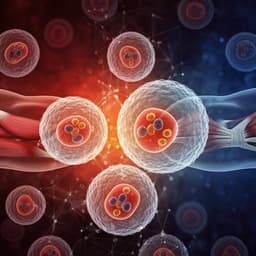
Chemistry
A robotic prebiotic chemist probes long-term reactions of complexifying mixtures
S. Asche, G. J. T. Cooper, et al.
Discover how a robotic prebiotic chemist, developed by Silke Asche, Geoffrey J. T. Cooper, Graham Keenan, Cole Mathis, and Leroy Cronin, is revolutionizing the exploration of complex chemical reactions. This groundbreaking system autonomously conducts experiments, revealing insights into the emergence of life from prebiotic chemistry through its innovative discoveries of high-complexity molecules.
~3 min • Beginner • English
Introduction
The study addresses the challenge of experimentally probing the emergence of life from abiotic chemistry over long timescales. Traditional laboratory experiments typically last hours to days, whereas prebiotic processes likely unfolded over millions of years. Unconstrained, multicomponent chemical systems are expected to generate highly complex product mixtures that are analytically intractable with conventional, targeted methods. The authors propose a robotic, closed-loop experimental platform capable of running long-duration, recursive chemical cycles with changing inputs and mineral environments, combined with automated online analytics and decision-making. The goal is to detect and drive increasing molecular complexity across cycles, enabling systematic, testable exploration of chemical space relevant to origins-of-life hypotheses.
Literature Review
The paper situates its work among theories and frameworks on the emergence of life, including geochemical origins of metabolism, membrane formation, and genetic molecules. Prior research often constrains chemical space for tractability, but this may miss environmentally driven dynamics relevant to early Earth. Studies have shown that cycling simple mixtures can yield diversification and differentiation of products, yet the vastness of reactions and timescales remains a barrier. Calls have been made for system-level analytics of messy chemistries and for long-term, bulk measurements. Machine-learning-driven chemical search engines and autonomous synthesis platforms demonstrate the promise of algorithmic discovery. The authors build on recursive chemistry studies that used metrics to avoid combinatorial explosions and on reaction prediction models (Molecular Transformer) to map potential reactivity of input libraries.
Methodology
Platform design: An automated, closed-loop system performs unconstrained multicomponent chemistry in recursive cycles on mineral surfaces with online LC-MS analysis and algorithmic control. Hardware includes five pumps (four syringe, one peristaltic), four liquid-handling valves (three inputs, one analysis), 18 aqueous input reagents, a nitrogen-purged reactor with reflux condenser on a controllable stirrer/hot plate, an HPLC-MS sampling loop, and a 20-position offline sample wheel (manually replenished every ~3 days). A peristaltic pump draws reactor liquid through a syringe filter to an external HPLC valve for MS injection. Python software controls operations and analyzes MS data.
Experimental protocol: Each run comprises 60–150 cycles of 3–12 h each. A clean, dry reactor is charged with washed minerals (quartz SiO2, ulexite NaCaB4O6(OH)6·5H2O, pyrite FeS2). At experiment start, three randomly assigned input solutions (from 18) are added (e.g., 30 mL each). The mixture is stirred at 300 rpm and heated to 70 °C. At the end of each cycle, stirring/heating stop and the reactor settles for 1 h to protect hardware. A sample is taken to the online analysis loop; ~70% of the product solution is removed to the sample wheel for offline analysis. Fresh input solutions replenish the reactor, and stirring/heating resume.
Decision algorithm (Mass Index): The LC-MS total ion chromatogram is processed spectrum-by-spectrum. Peaks above an intensity threshold (10^6) are considered. The Mass Index (MI) is defined as (m_max − m_min)/N_peaks over threshold. MI is stored per cycle and the slope between cycles is computed. After a minimum number of cycles with a given input set (typically 10), if the MI slope is ≤ 0 (below threshold), the algorithm randomly changes the input composition; if positive, it continues. The MI heuristic detects trends such as combinatorial explosion (low MI) or emergence of dominant heavy species (high MI). Alternative algorithms (e.g., mass-by-intensity weighting, information entropy) were evaluated in SI and tracked with MI but were not used for control due to simplicity and speed requirements.
Reaction space simulation: Using the Molecular Transformer model, all two- and three-component combinations from the 18-input library were assessed. Predictions with score > 0.8 yielded 2206 possible reactions, visualized as reactant–product networks, illustrating the vast potential for complex mixtures and motivating system-level analytics.
Analytics: Online LC-MS used an Advion expression L-CMS, positive/negative switching with only positive-mode data fed to the control algorithm (m/z 10–2000). Offline, selected samples were analyzed by UHPLC-Orbitrap (Thermo Fusion Lumos) for higher-resolution comparison across runs. HPLC-DAD conditions and MS parameters, mineral washing procedures, mobile phase preparation, and input solution concentrations (generally 0.1 M; RuCl3·xH2O at 0.01 M) are provided. Data and code availability are noted (Supplementary Data 1).
Key Findings
- Autonomous long-term operation: The platform executed >10 experiments, each with 60–150 recursive cycles, continuously over >4 weeks. One example ran 65 cycles of 12 h each (780 h, 32.5 days).
- Algorithmic control of complex mixtures: The MI-based heuristic enabled on-the-fly input changes to push systems out of steady states, exploring diverse trajectories without manual intervention.
- Emergence of heavy species and handling of large datasets: Four of six highlighted runs exhibited periods of progressively increasing MI, indicating formation/persistence of heavier species and/or reduction in number of above-threshold peaks. Two runs showed more static behavior.
- Quantitative outcomes (from Fig. 4):
• Run A: Highest MI 9.63 with 5029 unique product species (cycle 63); up to 5256 unique species observed in a single cycle (cycle 65) with MI 9.12.
• Run F: Highest MI 8.67 with 316 species.
• Run E: Highest MI 8.45 with 81 species (lowest species count among compared runs).
• Run B: MI 7.5 with 99 species.
• Run D: MI 7.05 with 70 species.
• Run C: Smallest highest MI 5.76 with 169 species (nearly static trajectory).
- Highest m/z analysis (Fig. 6): Across experiments, median of highest m/z per cycle was <240 m/z, with many cycles producing species heavier than the heaviest input (red line reference). A cluster around ~240 m/z was common, despite differing inputs and conditions. Initial cycles often showed unusually high highest m/z, attributed to mineral surface effects (adsorption/leaching/catalysis) that diminish after early cycles.
- Reproducibility study: Repeating an identical input trajectory (Runs 10, 11, 12) without algorithmic decisions revealed overlapping yet distinct product distributions, with many shared products but notable differences, especially at higher m/z; MI trajectories differed across repeats. Differences likely arise from mineral surface variability and MS ionization variability, amplified across recursive cycles.
- Avoidance of combinatorial explosion: The recursive dilution and MI-driven input changes constrained the chemical space, allowing persistence of robust species and preventing unchecked growth in detected features.
- Capacity to discover increasing complexity: Some trajectories showed increasing MI despite input changes, suggesting the formation and persistence of higher-mass or more selected product ensembles.
Discussion
The robotic prebiotic chemist addresses the need for long-term, autonomous exploration of unconstrained multicomponent chemical systems pertinent to the origin of life. By coupling recursive cycling on mineral surfaces with online LC-MS and a simple MI-based decision rule, the system can detect global changes in product distributions and steer experiments accordingly. The findings demonstrate that complex mixtures can be probed and modulated without targeting specific molecules, revealing periods of increasing molecular weight dominance and persistence across cycles, while avoiding combinatorial explosions. Variability between repeated runs underscores the sensitivity to mineral environments and the stochasticity of such messy systems, yet shared product subsets suggest underlying reproducible pathways. The observed clustering of highest m/z around ~240 m/z across diverse conditions points to emergent constraints in these chemistries. Overall, the platform provides a testbed to interrogate hypotheses about selection and complexification in prebiotic-like chemical networks, enabling data-driven adjustments and paving the way for studying how robust species persist and potentially amplify outside biological systems.
Conclusion
The study introduces a fully automated, algorithmically controlled platform capable of running weeks-long, recursive, multicomponent prebiotic chemistry experiments on minerals with online analytics and real-time decision-making. A reaction prediction survey (2206 predicted reactions) validates the high potential for complexification from a modest 18-reagent library. The Mass Index heuristic provides a simple, fast, system-level metric to guide exploration, enabling the platform to modulate inputs and avoid combinatorial explosions while occasionally driving increases in apparent molecular complexity. Experiments revealed both shared and run-specific product features, especially at higher m/z, and a common emergence zone around ~240 m/z. The platform supports testing origins-of-life hypotheses by adapting feedstocks in response to observed chemistry and suggests mechanisms for persistence of species over cycles. Future work includes enhancing decision algorithms (e.g., information-theoretic or assembly-theory-informed metrics), deeper characterization of mineral surface interactions (e.g., microscopy, MALDI-TOF), and leveraging assembly theory with mass spectrometry to track selection and complex molecule formation under prebiotic conditions.
Limitations
- Algorithmic simplicity: The Mass Index captures only a coarse aspect of spectra and cannot represent full mixture complexity; alternative metrics showed similar trends but did not yield deeper insights, and were not adopted for control due to computational simplicity requirements.
- Reproducibility constraints: Repeated runs with identical input trajectories produced differing MI curves and high-m/z features, likely due to subtle mineral surface variations and MS ionization variability; thus generalizability across runs is limited.
- Analytical biases: MS favors detection of smaller, well-ionizing species; thresholding (10^6 intensity) and choice of positive mode influence detected feature sets; online analytics failed in one repeat run (Run 12), limiting comparability.
- Mineral effects: Early-cycle anomalies (high highest m/z) may stem from leaching/adsorption/catalysis on freshly washed minerals; mineral surfaces were not fully characterized during runs.
- Experimental scope: The 18-reagent library is human-selected and biased; nitrogen atmosphere and specific conditions may not reflect all prebiotic scenarios; manual intervention was required to replace sample wheel vials every ~3 days.
- No universal trend: Not all runs showed increasing MI; some remained static or fluctuated, indicating that input changes do not guarantee progressive complexification under all conditions.
Related Publications
Explore these studies to deepen your understanding of the subject.







